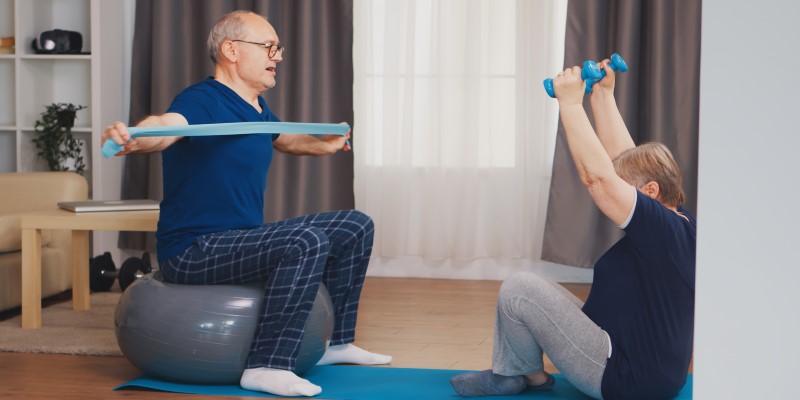
As we age, it becomes increasingly important to maintain our physical health and strength. One of the most effective ways for older adults to achieve this is through strength training. While many may associate strength training with younger individuals or athletes, its benefits for older adults are profound and can significantly enhance the quality of life.
What to Know About Strength Training?
Strength training is a highly beneficial exercise that improves muscle strength, endurance, and overall fitness. It involves performing resistance-based exercises using weights, resistance bands, or body weight to challenge the muscles.
Understanding the principles of strength training, such as proper form, progressive overload, and adequate recovery, is essential for maximizing results while minimizing the risk of injury. Incorporating a well-rounded strength training program into your fitness routine can enhance muscle mass, boost metabolism, improve bone density, and support overall health and well-being.
Why Strength Training for Older Adults?
Strength training is not just for the young and athletic; it holds immense value for adults of all ages, especially as we navigate the journey of aging. Here are a few benefits of strength training that adults can experience:
Maintaining Muscle Mass: Aging often leads to declining muscle mass and strength. Regular strength training exercises allow older adults to preserve and even increase muscle mass, which is essential for maintaining mobility and independence.
Improving Bone Health: Strength training isn't just about muscles but promotes better bone health. As we age, our bones become more susceptible to fractures and osteoporosis. Strength training exercises, especially those that involve weight-bearing movements, help to strengthen bones and reduce the risk of fractures.
Enhancing Metabolism: Another advantage of strength training is its ability to boost metabolism. As we age, our metabolism tends to slow down, making it easier to gain weight and harder to lose it. Strength training helps increase muscle mass, which can lead to a higher metabolic rate, making it easier to maintain a healthy weight.
Improved Functional Capacity: Strength training improves overall functional capacity, making daily tasks such as lifting groceries, climbing stairs, and getting up from a chair easier and more manageable.
Enhanced Balance and Stability: Older adults are more prone to falls, which can result in serious injuries. Strength training exercises that target balance and stability, such as squats and lunges, help to improve proprioception and reduce the risk of falls.
Mental Well-being: Exercise, including strength training, has positively affected mental well-being. It can reduce symptoms of anxiety and depression, improve cognitive function, and enhance overall mood and outlook on life.

Getting Started with Strength Training
After exploring the benefits of strength training for older adults, it's essential to understand how to get started safely and effectively. That said, here are a few strategies that will surely prove helpful in this regard.
Consulting a Healthcare Professional:
Consulting a healthcare professional is crucial before diving into any new exercise routine, especially for older adults with existing health concerns. These experts can assess individual health status, identify limitations, and offer personalized recommendations for safe and effective exercises tailored to specific needs and conditions. By seeking professional guidance, older adults can minimize the risk of injury and maximize the benefits of their strength training journey.
Start Slowly:
Commencing the strength training journey requires a deliberate and cautious approach, particularly for older adults. Instead of jumping into intense workouts immediately, starting slowly and gradually increasing the intensity over time is advisable. This progressive approach reduces the risk of injury and allows the body to adapt to new demands, laying a strong foundation for long-term success.
Focus on Proper Form:
Mastery of proper form is essential in strength training, especially for older adults. Certified personal trainers or fitness instructors can guide you to ensure exercises are performed correctly, maximizing benefits while minimizing the risk of injury. With proper form, individuals can target specific muscle groups effectively and avoid unnecessary strain on joints and ligaments.
Additionally, focusing on technique enhances the overall efficacy of each exercise, allowing for optimal muscle engagement and progression.
Incorporating Strength Training into Daily Life
Now that we understand the fundamentals of starting strength training let's explore how to seamlessly integrate it into our daily lives.
Make it a Routine:
Consistency forms the bedrock of any successful strength training regimen. Aim to schedule at least two to three weekly sessions dedicated to strength training. By establishing a routine, you build momentum and provide your body with consistent stimuli for muscle growth and development. Set specific days and times for your workouts, treating them equally important to any other appointment or commitment.
Variety is Key:
Sticking to the same exercises daily can quickly lead to boredom and plateaus in progress. To keep things engaging and ensure comprehensive muscle development, incorporate a variety of strength training exercises into your routine. Explore different equipment, techniques, and workout formats to target various muscle groups effectively.
Listen to Your Body:
While consistency and variety are crucial, listening to your body and respecting its signals during strength training is equally important. Pay attention to how your body responds to each exercise, noting any discomfort, pain, or unusual sensations.
If something doesn't feel right or causes discomfort, don't hesitate to modify the exercise or seek guidance from a qualified fitness professional. Remember, strength training aims to enhance your health and well-being, not to push through unnecessary pain or discomfort.

Conclusion
Strength training is a valuable component of overall health and well-being for older adults. It offers numerous benefits, including improved muscle mass, bone health, metabolism, functional capacity, balance, stability, and mental well-being. By incorporating strength training into their daily lives, older adults can maintain independence, reduce the risk of falls and fractures, and enjoy a higher quality of life well into their golden years.


